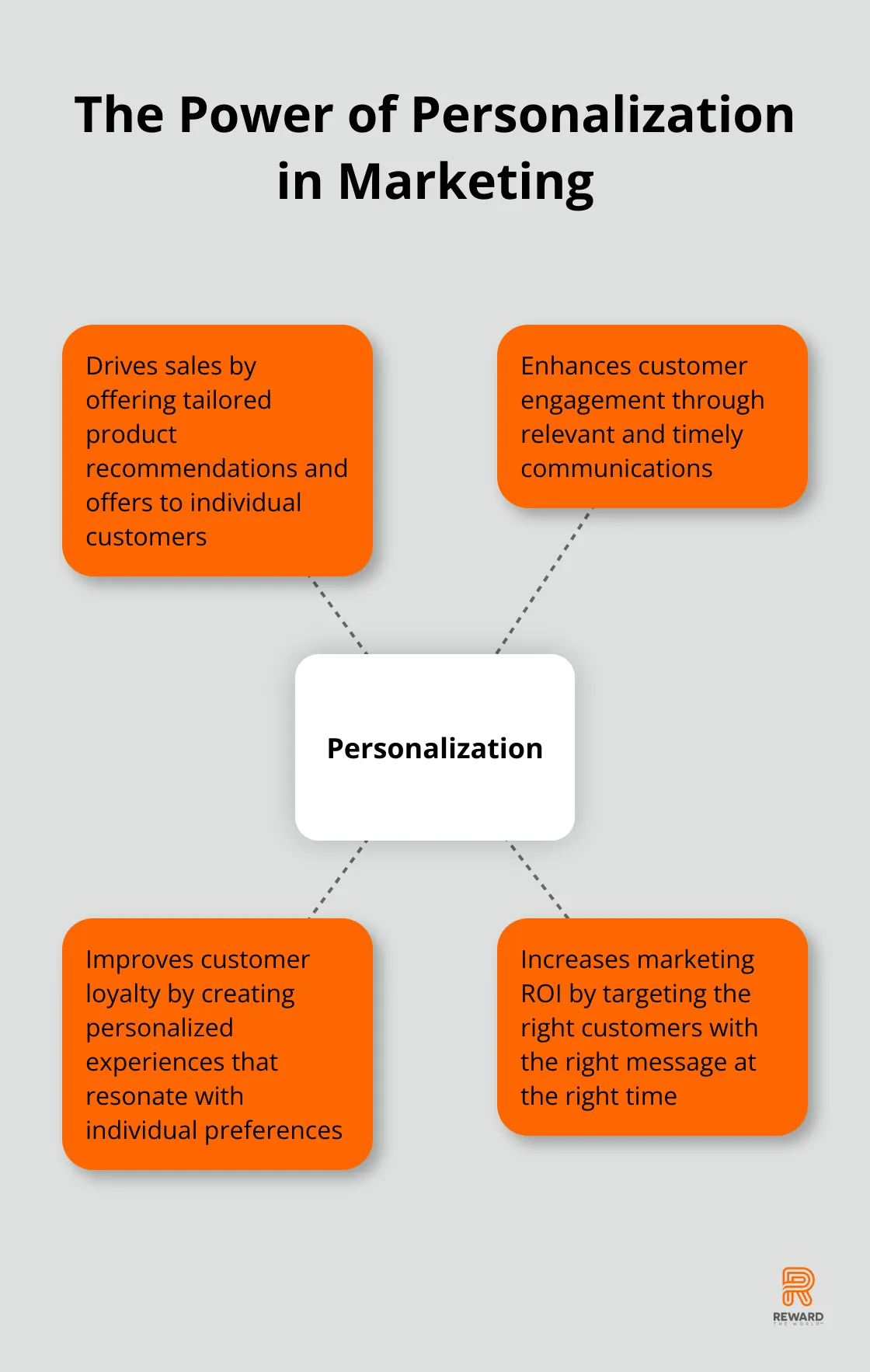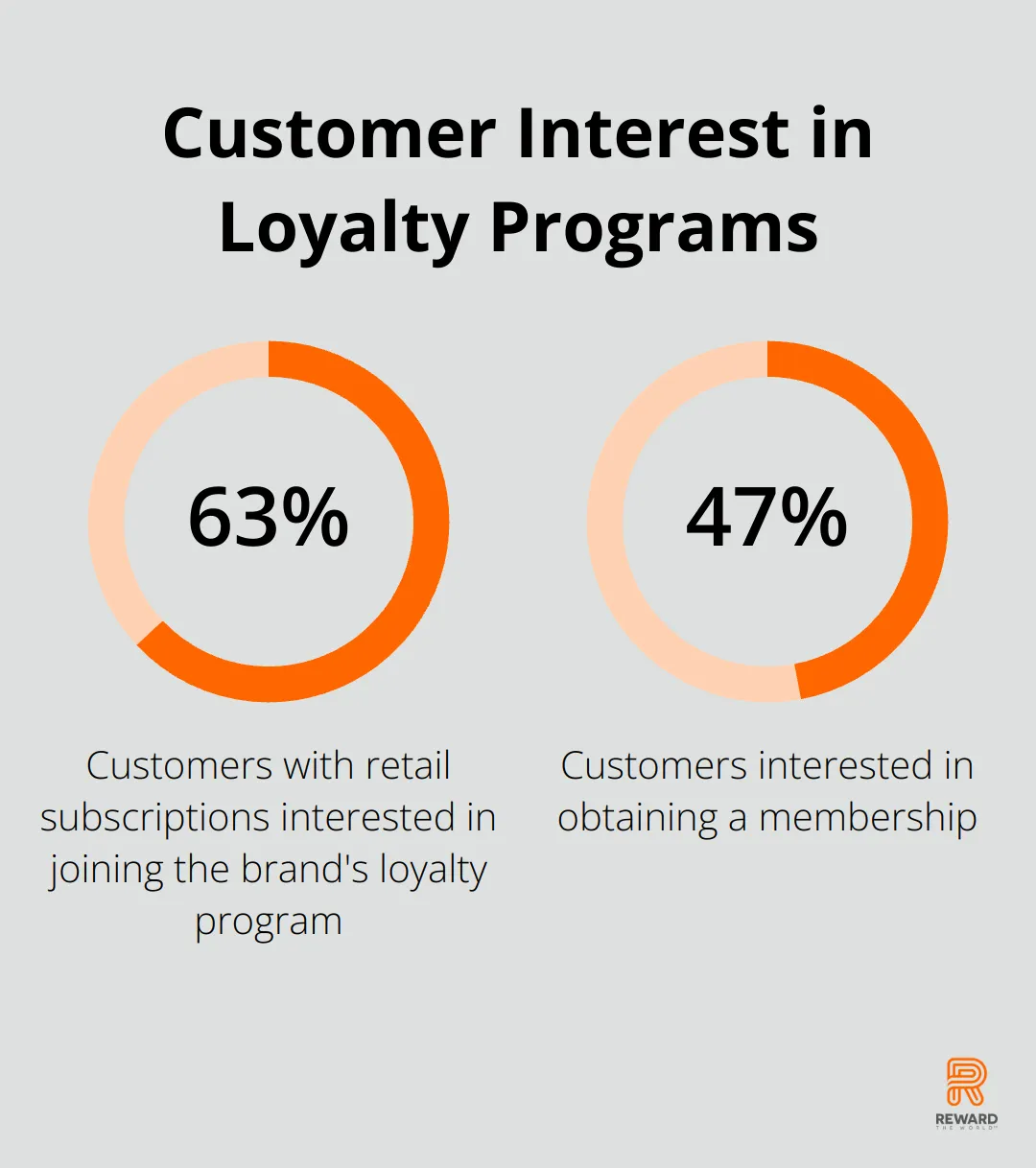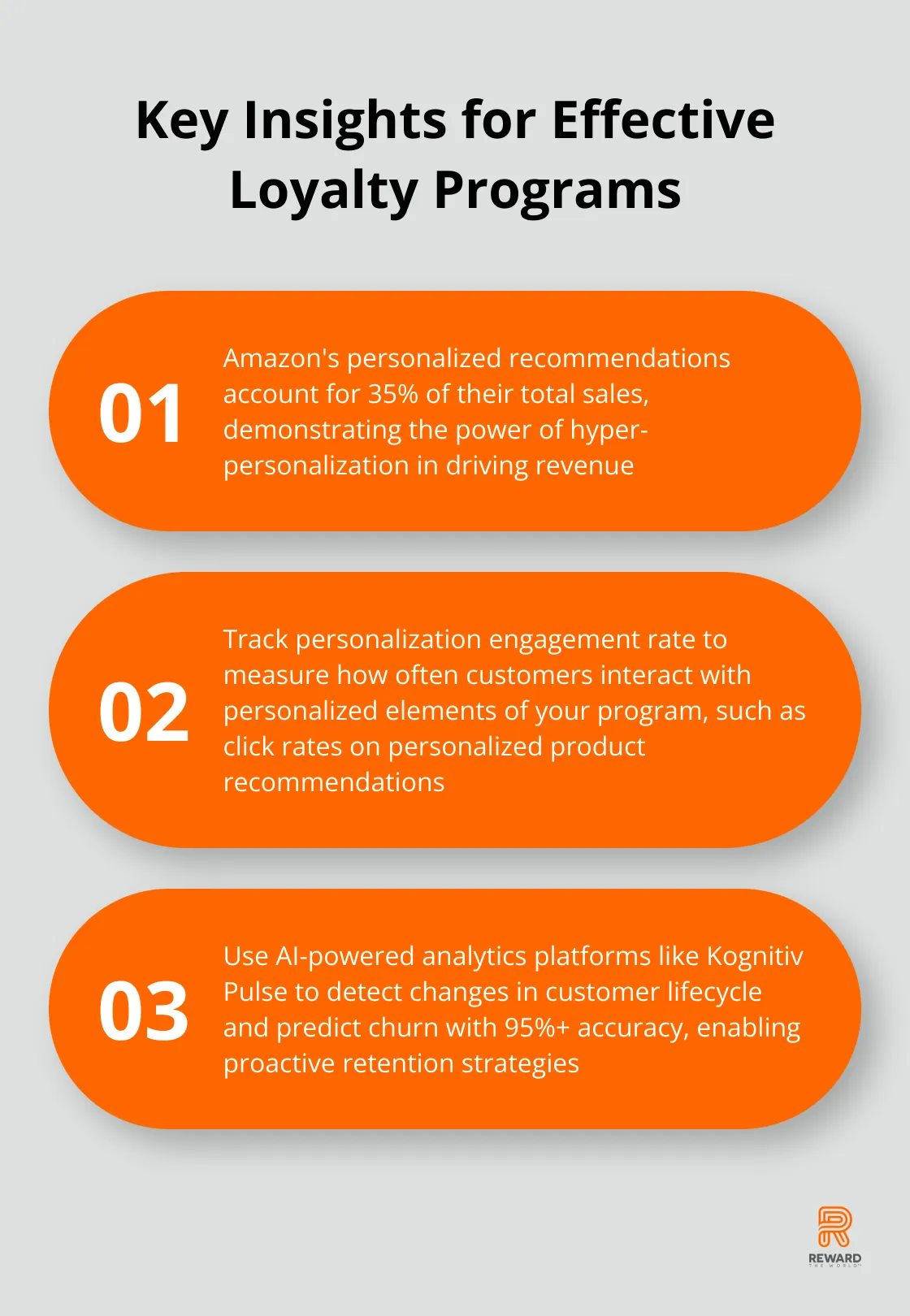
Hyper-personalized loyalty programs are revolutionizing customer engagement. By harnessing the power of AI personalization, businesses can create tailored experiences that resonate with individual customers on a deeper level.
At Reward the World, we’ve seen firsthand how these advanced programs drive customer retention and boost revenue. This guide will show you how to implement and measure the success of hyper-personalized loyalty strategies in your business.
What Is Hyper-Personalization in Loyalty Programs?
The Evolution of Customer Loyalty
Hyper-personalization in loyalty programs transcends basic segmentation. It creates unique, tailored experiences for each customer based on their individual preferences, behaviors, and interactions with a brand.
The Power of AI and Data Analytics
AI and advanced analytics transform raw customer data into actionable insights. These technologies predict customer needs and preferences with remarkable accuracy. New research from Epsilon uncovers how consumers feel about personalization in marketing and advertising. This underscores the potential of hyper-personalized loyalty programs in driving sales and customer engagement.

Traditional vs. Hyper-Personalized Programs
Traditional loyalty programs often rely on broad segmentation and generic rewards. They might offer the same discount to all silver-tier members, regardless of individual preferences or purchase history.
Hyper-personalized programs tailor rewards to each customer’s unique profile. Instead of a generic 10% off coupon, a hyper-personalized program might offer a free upgrade on a customer’s favorite product based on their purchase history.
The Fuel of Hyper-Personalization: Data
Data powers hyper-personalization. A McKinsey report reveals that leaders struggle to turn the data they collect into action. Behavioral insights can help create a bridge between information and results.
To create truly tailored experiences, businesses need to collect and analyze various types of data:
- Transactional data: Customer purchases, frequency, and price points.
- Behavioral data: Customer interactions with websites, apps, or in-store.
- Contextual data: Time, location, device used for purchases.
- Feedback data: Customer reviews, survey responses, and support interactions.
The combination of these data points creates a 360-degree view of each customer, enabling truly personalized experiences. Combining loyalty program data with other customer data sources allows you to create more detailed customer profiles and refine your segmentation strategies.
Building a Customer-Centric Culture
Implementing a hyper-personalized loyalty program requires more than just technology. It demands a commitment to understanding and serving each customer as an individual, not just a segment or demographic.
As we move forward, we’ll explore how businesses can implement these hyper-personalization strategies effectively, leveraging AI and machine learning to create dynamic customer segments and develop personalized rewards.
How to Implement Hyper-Personalization in Loyalty Programs
Harness AI for Deep Customer Insights
AI and machine learning transform loyalty program personalization. These technologies analyze vast amounts of customer data to uncover patterns and preferences that humans might overlook. AI predicts when a customer might churn based on subtle behavioral changes, allowing for timely intervention with targeted offers.
AI loyalty programs can proactively engage customers with relevant offers and experiences in real-time, increasing the effectiveness of personalization efforts.
To start, collect quality data from multiple touchpoints (transaction history, website behavior, app usage, and customer service interactions). Then, use AI-powered analytics tools to process this data and generate actionable insights.
Create Dynamic Customer Segments
Dynamic segmentation uses real-time data to continuously update customer profiles and groupings.
Loyalty segmentation aims to boost customer lifetime value by retaining high-value customers for longer. This approach allows for more targeted and effective engagement strategies.
To implement dynamic segmentation:
- Identify key behavioral indicators that align with your business goals.
- Use AI-powered tools to analyze these indicators in real-time.
- Set up automated systems to adjust customer segments as behaviors change.
Craft Personalized Rewards and Offers
Dynamic segments enable highly targeted rewards and offers. The key is to make these offers feel truly personal and valuable to each customer.
For example, if you identify a segment of customers who frequently purchase organic products, offer them early access to new organic lines or partner with local organic farms for exclusive discounts.
A recent study found that 63% of customers with retail subscriptions are interested in joining the brand’s loyalty program, and 47% are interested in obtaining a membership. This finding highlights the importance of innovative, tech-driven reward strategies.

Implement Real-Time Engagement Tactics
Real-time engagement maintains relevance in today’s fast-paced digital landscape. This means responding to customer actions and preferences as they happen.
For instance, if a customer browses a particular product category on your website but doesn’t make a purchase, send them a personalized offer for items in that category immediately.
Or, if a customer reaches a new tier in your loyalty program, notify them instantly and provide a special reward to celebrate their achievement.
To implement real-time engagement:
- Set up triggers based on specific customer actions or milestones.
- Create a library of personalized responses or offers for each trigger.
- Use automation tools to deliver these responses instantly across various channels (email, app notifications, SMS).
The goal of hyper-personalization is to make each customer feel uniquely valued and understood. Leveraging AI, creating dynamic segments, crafting personalized rewards, and engaging in real-time creates a loyalty program that truly resonates with customers on an individual level. As we move forward, it’s essential to measure the success of these hyper-personalized strategies to ensure they deliver the desired results.
How to Measure the Effectiveness of Your Hyper-Personalized Loyalty Program
Key Performance Indicators for Advanced Programs
Measuring the success of a hyper-personalized loyalty program requires looking beyond traditional metrics. While customer retention rate and average order value remain important, consider these more nuanced KPIs:
- Personalization Engagement Rate: This measures how often customers interact with personalized elements of your program (e.g., click rates on personalized product recommendations).
- Individual Customer Lifetime Value (CLV): Track how CLV changes over time in response to personalized interventions. When measuring CLV, it’s best to look at the total average revenue generated by a customer and the total average profit.
- Redemption Rate Variance: Compare redemption rates for personalized offers against generic ones. A successful hyper-personalized program should see significantly higher redemption rates for tailored offers.
- Customer Feedback Score: Use surveys or Net Promoter Score (NPS) specifically for your loyalty program to gauge customer satisfaction with the level of personalization.
- Cross-Sell/Upsell Success Rate: Track how often customers purchase products recommended based on their personal data and preferences.
Advanced Tools for Program Effectiveness
To effectively track these KPIs, you’ll need sophisticated analytics tools. Here are some options:
- AI-Powered Analytics Platforms: Tools like Kognitiv Pulse can detect changes in customer lifecycle and predict churn with 95%+ accuracy.
- Customer Data Platforms (CDPs): Platforms like Segment or Tealium unify data from multiple sources, giving you a 360-degree view of each customer.
- A/B Testing Tools: Use tools like Optimizely to test different personalization strategies and measure their impact.
- Predictive Analytics Software: Platforms like RapidMiner can help forecast future customer behavior based on personalization efforts.
Real-World Success Stories
Let’s examine some businesses that have successfully implemented and measured hyper-personalized loyalty programs:
Sephora’s Beauty Insider program uses purchase history and beauty preferences to offer personalized product recommendations and samples. Tracking individual customer engagement with these personalized offers, Sephora saw a 70% increase in purchase frequency among program members.
Starbucks’ rewards app uses AI to analyze customer purchase history and location data to send hyper-personalized offers. This artificial intelligence-powered approach is boosting its rewards program effectiveness, incentivizing consumers to spend more and visit more frequently.
Amazon Prime analyzes browsing and purchase history, creating tailored product recommendations for each customer. Amazon measures success by tracking the click-through and conversion rates of these personalized recommendations, which account for 35% of their total sales.

These impressive results highlight the potential of hyper-personalized loyalty programs. However, Reward the World offers similar capabilities with even more flexibility and a wider range of reward options (making it an excellent choice for businesses looking to implement such programs).
Continuous Improvement Strategies
To maximize the effectiveness of your hyper-personalized loyalty program:
- Regularly review and update your KPIs to ensure they align with your business goals.
- Conduct frequent A/B tests to optimize your personalization strategies.
- Collect and analyze customer feedback to identify areas for improvement.
- Stay updated on the latest AI and machine learning advancements to enhance your personalization capabilities.
- Train your team to interpret and act on the data insights generated by your analytics tools.
Final Thoughts
Hyper-personalized loyalty programs revolutionize customer engagement through AI personalization. These advanced systems create tailored experiences that resonate with individual customers, driving retention and boosting revenue. The future of loyalty program personalization will integrate more sophisticated AI and machine learning technologies, enabling real-time personalization across all customer touchpoints.
Businesses must commit to understanding individual customer needs to implement hyper-personalization effectively. This commitment involves collecting quality data from multiple sources and investing in AI-powered analytics tools to generate actionable insights. Companies should develop strategies for crafting personalized rewards and offers that truly resonate with each customer segment.
Reward the World offers a comprehensive solution for businesses aiming to implement hyper-personalized loyalty programs. Our platform provides instant reward delivery, seamless integration, and robust analytics (making it an ideal choice for companies looking to elevate their customer engagement strategies). Businesses that embrace AI personalization in their loyalty programs will position themselves to thrive in an increasingly competitive marketplace.
